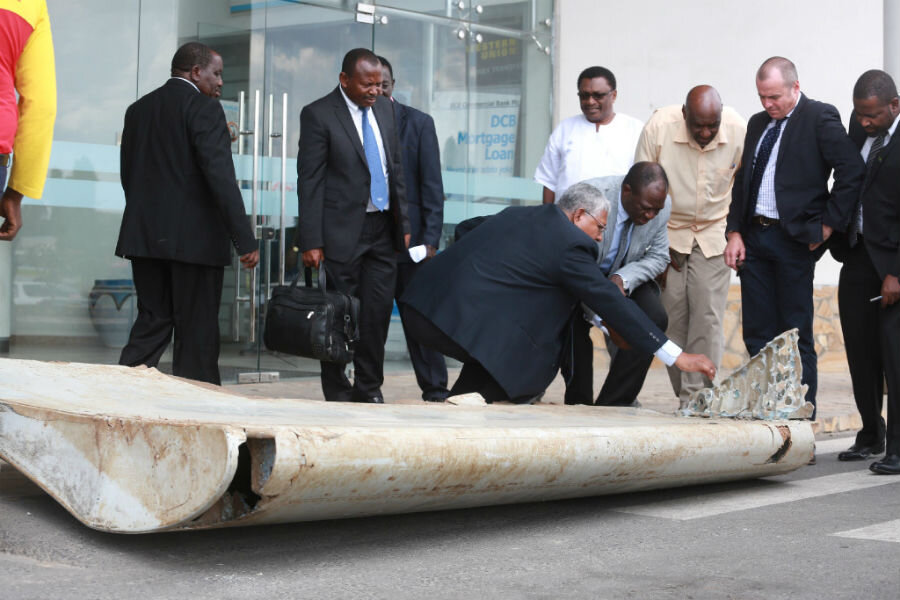Is the MH370 disappearance the Titanic of modern times?
Loading...
Since the Malaysia Airlines Flight 370 (MH370) disappeared in March 2014, the doomed plane has generated headline after headline of speculation about the ultimate fate of the plane, the location of the crash site, and the cause of the tragedy.
Every new report and discovery reignites public interest in the ongoing search for the plane. After two and a half years of analysis and guesswork, MH370 has attained a pseudo-legendary status reminiscent of the response to the sinking of the Titanic.
The ongoing interest in the plane's disappearance raises moral questions about the mythologizing of real events, particularly ones in which many victims lost their lives.
When MH370 disappeared from flight radars in 2014, it was hardly the first time a commercial airliner had crashed. But as rescue efforts turned up nothing, the mystery surrounding the disappearance began to mount, fueled by rampant speculation on social media and the news.
Most recently, the Australian Transport Safety Bureau examined a piece of the Boeing aircraft wing found off the coast of Tanzania and concluded in a report released Wednesday that the plane made an uncontrolled, steep dive into the ocean. Investigators hope this information will confirm they are searching in the right area for the remains of the craft.
The report comes as a team of global experts began a three-day summit in Canberra, Australia to re-examine all the data associated with the hunt for the plane, which vanished during a flight from Kuala Lumpur to Beijing on March 8, 2014, with 239 people on board, The Associated Press reports.
More than 20 items of debris suspected or confirmed to be from the plane have washed ashore on coastlines throughout the Indian Ocean. But a deep-sea sonar search for the main underwater wreckage has found nothing. Crews are expect to complete their sweep of the 120,000-square kilometer (46,000-square mile) search zone by early next year and officials have said there are no plans to extend the hunt unless new evidence emerges that would pinpoint a specific location of the aircraft.
The lost flight evokes tragedies like Sir John Franklin's lost expedition to the North Pole or the disappearance of Amelia Earhart as well as the sinking of the Titanic on its maiden voyage.
Julie Williams, a Titanic historian at at Samford University in Birmingham, Ala., points out that the famous shipwreck prompted avid speculation that led to the mythologizing of the sinking even before the survivors arrived in New York. Dr. Williams is a descendant of one of the surviving passengers, Albert Caldwell.
"My great-uncle could buy a Titanic postcard as soon as he arrived on the dock from the rescue ship," she tells The Christian Science Monitor. "It says something about how quickly an entrepreneurial person swept up the idea and took a supposed picture of the Titanic – it was probably actually Olympic, the sister ship with the name painted over it ... But the same thing happened in social media with the Malaysian airliner."
Williams draws a parallel between these rapidly-produced commemorative Titanic postcards and the initial response to the MH370 disappearance on sites like Twitter and Facebook. She specifically recalls an "irreverent meme" that compared the missing flight to the characters of the 1960s sitcom, "Gilligan's Island," which also took little heed of the victims or their potentially grieving families.
In the days following the plane's disappearance, speculation about what had happened ranged from sober analysis of the available facts to wild conspiracy theories. MH370 became a public sensation, much like the Titanic, with the first fictionalized novella about the disappearance of the plane appearing only three months after the presumed crash.
Since then, a number of TV documentaries, more memes, and books have revisited the still-incomplete search for the missing plane. CNN even put the missing flight on a list of history's biggest mysteries along with the Loch Ness Monster and Bigfoot in 2014.
In this sense, MH370 seems to have attained a status similar to a modern Titanic, retaining longevity due to just the right combination of social media discussion, occasional intriguing discoveries, and portrayal in the media.
"Titanic was supposed to be unsinkable. In this day and age, how can a large plane be un-locatable unfindable, untraceable?" William Nesbitt, a professor of English and chair of the department of humanities at Beacon College, tells the Monitor in an email. "We just can’t fathom how it can disappear and never reappear."
Williams says that the desire to unravel the mystery of a tragedy like this is simply human nature, and warns that if it captures the imagination enough, it can become something of a public obsession, fueled by media hoping to retain the public's attention.
"There's a sense that maybe we can do something by writing about it," says Williams. "I think we often have that opinion that exposing the truth will solve an error in the future, although it doesn't always."
She points out that this some people get wrapped up in the sensationalism of solving a mystery at the expense of respecting the victims, but acknowledges that the attention can help focus attention towards resolving lingering questions in a case like MH370.
In this case, the missing flight prompted the UN’s World Radiocommunication Conference to agree last year to allow satellites to receive specialized transmissions that aircraft currently send to other planes and to ground stations. The intent is to use part of the radio spectrum as a global flight tracking system in an effort to prevent any other planes from disappearing from the skies apparently without a trace.
"The public eye has more power than most of us realize," says Williams.








